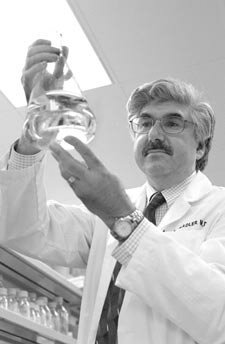|
In the U.S. alone, 18 million people currently suffer from diabetes. The Center for Disease Control's estimates suggest people born after 2000 have a 1-in-3 chance developing some form of diabetes during their lifetime.
"All the predictions, unfortunately, have been underestimates," notes UVA endocrinologist and physician Jerry Nadler, UVA Health System's chief of endocrinology and metabolism who believes the disease could become "the next world epidemic."
Without changes in lifestyle and new treatment options, he and his medical peers predict more than 350 million people worldwide will become diabetic in the next 25 years.
Despite the gloomy prospects, Nadler and his UVA colleagues are looking on the bright side.
Five years ago, Nadler, 52, was lured from the City of Hope Hospital in Los Angeles to help UVA grow its strong but small endocrinology division into an important player in diabetes care.
The affable and mustachioed researcher claims he "likes challenges." He's good at them, too. Following his recruitment of new physician scientists and major new grant support, U.S. New and World Report ranked the division as one of the nation's top five in 2004.
"Jerry has been very successful at identifying bright young people and attracting them to UVA as well as expanding the programs here," says Eugene Barrett, director of UVA's Diabetes Research Center and former president of the American Diabetes Association.
The bigger challenge for these spirited colleagues, however, lies in exploring new means of preventing and even reversing the onset of diabetes, ideally helping their patients eliminate dependence on daily blood sugar checks and the needling pain of daily insulin injections.
Besides examining lifestyle changes, researchers are studying cell transplants from donated pancreases as well as drugs designed to protect key insulin-producing pancreatic cells from future damage.
The division chief is currently principal investigator of a $9.3 million NIH grant that has endocrinologists and cardiologists at UVA collaborating on why diabetes patients so often end up with heart disease, two leading causes of death. Being the only academic medical center around for miles is a "big plus" for cross-disciplinary research. "By design, Nadler says, "it forces people to work together."
Frequent new reports about obesity, poor diets, and sedentary lifestyles– the biggest triggers for this ever-increasing diseaseplus the somber statistics about diabetes could generate a whopping dose of pessimism.
"There are two ways to look at diabetes," says Barrett. "You can throw up your hands, or understand that because things are getting worse, your job is more important than ever."
Dr. Nadler appears to be taking the latter course.

Jerry Nadler
PHOTO BY JEN FARIELLO
#
|